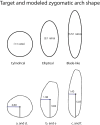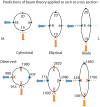The Biomechanics of Zygomatic Arch Shape
- PMID: 27870343
- PMCID: PMC5726875
- DOI: 10.1002/ar.23484
The Biomechanics of Zygomatic Arch Shape
Abstract
Mammalian zygomatic arch shape is remarkably variable, ranging from nearly cylindrical to blade-like in cross section. Based on geometry, the arch can be hypothesized to be a sub-structural beam whose ability to resist deformation is related to cross sectional shape. We expect zygomatic arches with different cross sectional shapes to vary in the degree to which they resist local bending and torsion due to the contraction of the masseter muscle. A stiffer arch may lead to an increase in the relative proportion of applied muscle load being transmitted through the arch to other cranial regions, resulting in elevated cranial stress (and thus, strain). Here, we examine the mechanics of the zygomatic arch using a series of finite element modeling experiments in which the cross section of the arch of Pan troglodytes has been modified to conform to idealized shapes (cylindrical, elliptical, blade-like). We find that the shape of the zygomatic arch has local effects on stain that do not conform to beam theory. One exception is that possessing a blade-like arch leads to elevated strains at the postorbital zygomatic junction and just below the orbits. Furthermore, although modeling the arch as solid cortical bone did not have the effect of elevating strains in other parts of the face, as had been expected, it does have a small effect on stress associated with masseter contraction. These results are counterintuitive. Even though the arch has simple beam-like geometry, we fail to find a simple mechanical explanation for the diversity of arch shape. Anat Rec, 299:1734-1752, 2016. © 2016 Wiley Periodicals, Inc.
Keywords: FEA; Pan troglodytes; force; shape; strain; stress; zygomatic arch.
© 2016 Wiley Periodicals, Inc.
Figures













References
-
- Ashman RB, Rho JY, Turner CH. Anatomical variation of orthotropic elastic moduli of the human proximal tibia. J Biomech. 1989;22:895–900. - PubMed
-
- Bramble DM. Origin of the mammalian feeding complex: models and mechanisms. Paleobiol. 1978;4(3):271–301.
-
- Buckland-Wright JC. Bone structure and the pattern of force transmission in the cat skull (Felis catus) J Morphol. 1978;155(1):35–61. - PubMed
Publication types
MeSH terms
Grants and funding
LinkOut - more resources
Full Text Sources
Other Literature Sources

